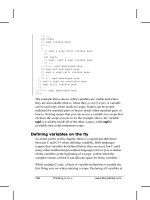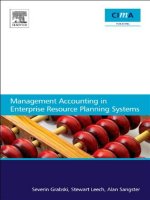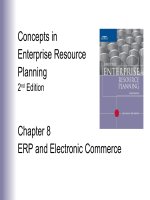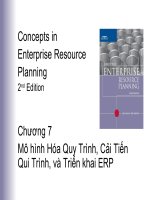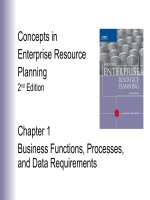Lecture concepts in enterprise resource planning (2nd edition) chapter 3 marketing information systems and the sales order process
Bạn đang xem bản rút gọn của tài liệu. Xem và tải ngay bản đầy đủ của tài liệu tại đây (569.12 KB, 62 trang )
Concepts in
Enterprise Resource
Planning
2nd Edition
Chapter 3
Marketing Information Systems and
the Sales Order Process
Chapter Objectives
• Describe the un-integrated sales processes of Fitter
Snacker, a fictitious company whose operations are used
as an example
• Explain why un-integrated Sales and Marketing
information systems lead to company-wide inefficiency,
higher costs, lost profits, and customer dissatisfaction
• Discuss sales and distribution in SAP’s R/3 system, and
explain how integrated data sharing increases companywide efficiency
• Describe how SAP R/3 processes a standard sales order
• Describe the benefits of Customer Relationship
Management software, a useful extension of ERP
software
Concepts in Enterprise Resource Planning, Second Edition
2
Introduction
• In most companies, the marketing function either
decides or has a key role in deciding:
• What products to produce
• How much of each product to produce
• How the products are to be promoted and advertised
• How the products should be distributed for maximum
customer satisfaction
• What price should be charged for the products
Concepts in Enterprise Resource Planning, Second Edition
3
Introduction
• Marketing and Sales is involved in generating key data:
• Recording sales
• Creating customer bills (invoices)
• Allocating credit to customers
• An integrated information system allows for efficient use
of transaction data
• Common database means data is consistent between
functional areas, but
• Incorrect data from one module will carry over to
other modules
Concepts in Enterprise Resource Planning, Second Edition
4
Overview of Fitter Snacker
• Fictitious Fitter Snacker Company produces two snack
bars:
• NRG-A: “Advanced Energy”
• NRG-B: “Body-building proteins”
• Fitter Snacker has two sales divisions:
• Wholesale: sells to middlemen who distribute bars to
small shops, vending machine operators, health food
stores
• Direct: large grocery stores, sporting goods stores,
other large chain stores
Concepts in Enterprise Resource Planning, Second Edition
5
Overview of Fitter Snacker
• Direct Sales: offers volume discounts to encourage large
orders which are more efficient to process
• Wholesale: charges lower fixed price because customer
orders are already large (otherwise, the customer would
be handled by Direct division)
• Both divisions offer terms of 2-10, net 30
• Customers receive a 2 percent discount if they pay
their invoices within 10 days
• Invoice is due in 30 days
• Fitter Snacker also sells bars in store-brand wrappers for
some chains
Concepts in Enterprise Resource Planning, Second Edition
6
Problems with Fitter Snacker’s Sales Process
• Fitter Snacker has separate information systems for
three functional areas:
• Sales order processing
• Warehouse management
• Accounting
• Sales transaction data is shared with accounting via
periodic file transfers
• Credit data is shared between accounting and sales via
paper printout
• High number of manual transactions leads to many
opportunities for data error
Concepts in Enterprise Resource Planning, Second Edition
7
Sales Process
• The Sales Process involves a series of steps that require
coordination between:
• Sales
• Warehouse
• Accounting
• Receiving
• Note that manufacturing is not generally involved in the
sales process as NRG bars are usually sold from
warehouse stock
Concepts in Enterprise Resource Planning, Second Edition
8
Sales Process
Concepts in Enterprise Resource Planning, Second Edition
9
Quotations
• Fitter Snacker’s current quotation process is a paperbased process
• Sales quotes are written up on a 3-part form:
• Original goes to customer
• First copy is faxed, then mailed, to sales office
• Salesperson keeps second copy for personal records
• Common problems include:
• Salesperson may make an arithmetic error or offer
incorrect discounts
• Customer may order before copy of quote is faxed
• Faxed copy may not be legible
Concepts in Enterprise Resource Planning, Second Edition
10
Sales Order
• Customers want delivery data when placing a sales
order
• Warehouse supervisor provides shipping date based
on estimation of inventory and orders outstanding
• Sales clerk uses shipping date plus shipping method
to determine delivery date
• Sales clerk checks credit for existing customers against
credit report generated on a weekly basis by accounting
• Report may not reflect most current orders or
payments
Concepts in Enterprise Resource Planning, Second Edition
11
Sales Order
• Sales order is entered in customer order computer
program that:
• Stores customer order data for sales analysis
• Prints out packing list and shipping labels for
warehouse
• Produces data file to create invoices
• Provides data file for accounting department for
financial, tax and managerial accounting purposes
Concepts in Enterprise Resource Planning, Second Edition
12
Order Filling
• Small customers buy in display box quantities
• Large customers buy in case quantities
• Sometimes cases are opened to fulfill small orders
• Expensive (wastes labor and packaging)
• Leads to inventory inaccuracy
• Inventory levels managed in a PC-based inventory
program
• Production records and packing lists are used to
update inventory levels
• Monthly physical inventory count used to check and
correct inventory records
Concepts in Enterprise Resource Planning, Second Edition
13
Order Filling
• When there is insufficient inventory to fill a customer
order
• The order can be delayed until more bars are
produced
• The available quantity can be shipped on time, with
the balance sent in a separate shipment when
available
• The available quantity can be shipped on time, with
the rest of the order cancelled
• Information that balance of order was cancelled
must be conveyed to accounting so correct invoice
can be prepared
• How to make correct decision is complicated at Fitter
Snacker
Concepts in Enterprise Resource Planning, Second Edition
14
Invoicing
• Accounting prepares the invoice three times per week
• Accounting department loads data from disk provided
by sales department
• Manual adjustments are made for changes to sales
order (e.g. partial shipments)
• When corrections aren’t made on time, faulty
invoices are sent
Concepts in Enterprise Resource Planning, Second Edition
15
Payment and Returns
• Numerous problems occur in receiving customer
payments
• Customers may not return a copy of invoice with
payment, making it harder to match payment to
customer order
• Customer may pay correct amount, even if invoice
was not correct
• Requires investigation by accounting
• Making sure customer merits 2% discount for timely
payment (2/10 net 30) requires manual effort
Concepts in Enterprise Resource Planning, Second Edition
16
Payment and Returns
• Customers may return out-of-date or spoiled snack bars
or damaged or defective cases
• Customer receives a credit for returned items
• Customer is supposed to get a returned material
authorization (RMA) number from Fitter Snacker to
put on the defective snack bars before shipping them
back
• Without RMA number, Fitter Snacker’s receiving
department does not know how to process returned
materials
• Without RMA, accounting has a difficult and timeconsuming task to credit proper account
Concepts in Enterprise Resource Planning, Second Edition
17
Payment and Returns
• If payments or return credits are not properly credited,
Fitter Snacker may believe that a customer is over their
credit limit and:
• Block a sales order that should be processed
• Send a dunning letter that should not be sent
Concepts in Enterprise Resource Planning, Second Edition
18
Sales and Distribution in ERP
• There may be up to six events for a sales order
• Pre-sales activity
• Sales order processing
• Inventory Sourcing
• Delivery
• Billing
• Payment
Concepts in Enterprise Resource Planning, Second Edition
19
Pre-Sales Activity
• Provide customer pricing information via:
• Inquiry: statement of prices for a particular customer
for a particular quantity of product
• Quote: a binding statement of prices for a particular
customer for a particular quantity of product
• Presales activities can also include marketing activities
such as sales calls, visits and mailings
• Customer and sales data stored in the ERP system
helps in preparing targeted marketing activities
Concepts in Enterprise Resource Planning, Second Edition
20
Sales Order Processing
• Process can start by pulling data from inquiry or quote
• Taking data directly from inquiry/quote that customer
has approved minimizes errors
• Process includes:
• Retrieving customer contact data
• Recording items to be purchased
• Determining pricing
• Quantity discounts
• Customer-specific discounts
• Done automatically by system based on
configuration settings
• Automatic credit check
Concepts in Enterprise Resource Planning, Second Edition
21
Inventory Sourcing
• Inventory records and production plans can be checked
to determine whether sufficient material will be available
to deliver customer’s order on time
• This available-to-promise (ATP) check includes shipping
times and considers weekend and holiday shutdowns
• System can recommend increased production based
on higher than expected sales
• Sales orders place a reservation on material so that
the material can’t be sold to another customer
Concepts in Enterprise Resource Planning, Second Edition
22
Delivery
• Delivery in SAP means creating an electronic document
that directs the warehouse to pick, pack and ship the
customer’s order
• Deliveries can be grouped and released to make
warehouse operations more efficient
Concepts in Enterprise Resource Planning, Second Edition
23
Billing and Payment
• The system creates an invoice by copying data from the
sales order
• The invoice can be printed and mailed to the customer,
faxed or transmitted electronically by EDI (electronic
data interchange) or the Internet
• The accounts receivable account is debited (increased)
and sales account is credited automatically
• The customer can make a payment by mailing a check
or electronically transmitting funds
• Timely recording of payments is important for properly
managing a customer’s credit limit
Concepts in Enterprise Resource Planning, Second Edition
24
Taking an order in SAP’s R/3
• To enter a sales order in SAP’s R/3, the sales order clerk
must identify the customer and material ordered to the
system
• SAP identifies customers and materials via a unique
number
• Search functions allow the sales order clerk to find a
customer or material number easily
Concepts in Enterprise Resource Planning, Second Edition
25

